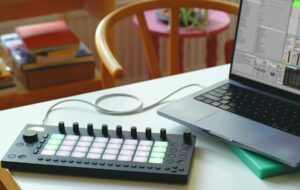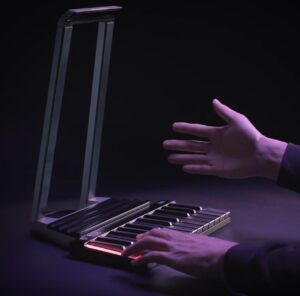Ableton Move
Ableton Move is a new portable, stand-alone “music creation” surface. Move has four tracks (drum, sampler, or synth) and a step sequencer. Move has audio input and output (3.5mm), built-in WiFi, 64GByte internal storage, built-in speaker and microphone, and an OLED screen (128×64 pixels). Control gizmos include 32 pads with polyphonic aftertouch, 9 touch-sensitive endless encoders and 16 multi-function buttons.
Like its competition (Yamaha SEQTRAK), Move is loaded with 1,500+ preset instruments, samples and drum hits. Three instruments are preloaded: Drift, Wavetable and Drum Sampler (plus Melodic Sampler).
Each track has up to two (insert) effects with two more for the Main Track. Effects include everb, Delay, Saturator, Chorus-Ensemble, Phaser-Flanger, Redux, Channel EQ and Dynamics.
Interesting — to me and other nerds — is the 1.5GHz quad-core ARM Cortex-A72 within. Wisely, Ableton included a USB-A port which means you can hook up your class-compliant controllers to Move. I wish this kind of “HOST” capability was standard everywhere on planet Earth.
Ableton Move is 313.5mm wide, 146.3mm deep, 34mm high. That’s 12.4 inches by 5.8″ for you English types.
Of course, Ableton Live Intro is bundled and Move knows about Ableton Live (and vice versa). With portability and integrated sound-making, I could see the Ableton Move becoming the prefered low-end Ableton Live controller. I have a boatload of mini controllers. At $449 USD, I could see Ableton Move replacing them all, even if I never do the on-the-go beat-making thing.
ROLI Airwave
If you ever wanted a Theremin, maybe a ROLI Airwave?
The ROLI Airwave lets you wave your hands about like The Amazing Kreskin, the mentalist. It connects to ROLI Piano M (formerly known as “Lumi Keys”) or ROLI Seaboard. Airwave supports gestures:
- Air Raise: Raise your hand up or down.
- Air Tilt: Turn your hand (rotate your wrist).
- Air Glide: Move your hand left/right over the keys.
- Air Slide: Move hands front to back over the keys.
- Air Flex: Change the angle of your wrist.
Put your hands in the air like you just… Oh, never mind.
The gestural thing is kind of neat. It would be cool to conduct a virtual orchestra, not just play keys. The tech is called “ROLI Vision”: “Airwave uses infrared cameras and ROLI Vision technology to reliably track all 27 joints in each of your hands at 90 frames per second. The data is converted into MIDI in real time, giving you incredibly precise control of your musical expression.”
ROLI Airwave is $299 USD and pre-order is available. And there are bundles.
Connectivity specs:
- 3.5mm TRS Headphone Output
- 3.5mm TRS Pedal input
- Two USB-C ports (data and power) plus a magnetic USB port for ROLI hardware
- Class compliant MIDI over USB and class compliant audio interface
Copyright © 2024 Paul J. Drongowski





